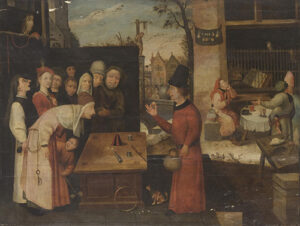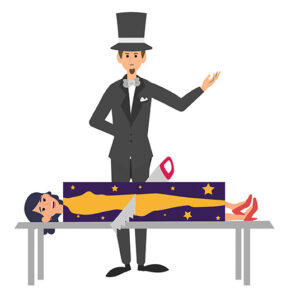
By Jeff Hecker, Principal, Athena Brand Wisdom, Toronto, Ontario, Canada, jeff.hecker@athenabrand.com
The magician invites an audience member to hold the divining pendulum. He explains that the “random” movement of the pendulum in her hand will guide whether they choose one card or another for the next part of his trick. If the pendulum swings in a circle, they’ll use card A, but if it swings back and forth in a line, they’ll use card B. Audience members reasonably assume that the magician has no way to influence what the pendulum does in the woman’s hand, but the magician knows better. By using some subtle priming language—such as talking about cycles or vortexes or, alternately, about a spectrum or tension between two points—the magician easily controls how the pendulum behaves.
Qualitative research is about understanding human behavior and the mind. We seek to understand how people process information and make decisions about what products and services they choose and use. To grow our research knowledge, we can leverage learning about cognition and perception from masters in other fields.
Magic is one such field. It might seem as though magicians rely on the sleight of hand, but the real work of magic is happening in the mind.
Arguably, magicians are the original neuroscientists, because everything they do—all the craft they’ve been developing for 3,000 years—depends on a deep understanding of the mind and the senses. Magicians have been puzzling our attention, perception, and cognition, seemingly bending or breaking reality through an understanding of how humans process sensory data into reality, how attention works, and how assumptions, mental shortcuts, and the fickleness of memory can be manipulated. They leverage that understanding to create the experience of magic.
As researchers, we need to be concerned with all these same issues. Attention, perception, cognitive shortcuts, and priming also affect how consumers perceive, choose, and experience brands, how they interact with us in research sessions, and how we need to interact with them.
What follows are three of the ways magicians can teach us something about how people think, with critical implications for us as researchers.
The Limits of Attention and Perception
Magicians can teach us about the limits of attention and perception. We can see magicians’ fluency with these limits in what’s commonly referred to as “misdirection.” Misdirection isn’t just magicians getting you to look at one spot while they’re doing something elsewhere. Misdirection has many forms and is more subtle and counterintuitive than distraction. Misdirection connects to how our attention and our senses function, and the different ways we can get things wrong.
One way our senses can err is called change blindness. This is the brain’s inability to recognize significant changes when more than one thing is happening. Magicians use change blindness to “hide” one change behind another. For example, magicians know that a manipulation they are doing to the top card of a deck can be made invisible simply by timing the manipulation to coincide with a moment they are moving the whole deck from one spot to another. Why? When the brain is presented with two changes simultaneously (a change to one card, and the movement of the whole deck), it can be too much for the brain to process. The brain does triage and only processes the bigger change; thus, the smaller change becomes invisible.

Another type of misdirection depends on the limits of attention. Specifically, that attention functions as a spotlight, illuminating what is at its center, while anything outside, or even on the periphery of our spotlight of attention, can become invisible. If you have seen the Monkey Business Illusion video1, you know how well this works. The more we are focused on one thing, the more that other things, even things happening right in front of us or on our body, become invisible.
This is the paradox we experience as observers of magic. We’re trying to avoid all the types of misdirection and figure out how tricks are done. But the harder we focus, the more difficult it is for us to understand what’s really happening.
The more our attention is focused on one thing, the more invisible other things become. It is just as this man in Hieronymus Bosch’s painting, focusing on the magician’s cups and balls trick, cannot simultaneously notice that he is being pickpocketed.
Conjuring the Magician’s View of Moderation
For researchers, these limits around attention and perception have significant implications. Given the “spotlight” nature of attention, we need to ask ourselves questions about how consumers are perceiving and processing advertising, packaging, and experiences.
- What part of a brand, ad, package, or idea are people focused on, and what are they missing?
- What part of web pages are consumers seeing and not seeing?
- What part of their experiences are consumers seeing and not seeing?
Like the magician, as researchers we need to think about where people’s eyes are going and not going, and help clients understand what they need to do to get people’s attention in the right places at the right times.
In our work, we also need to think about how we are managing respondent attention:
- How does respondent attention work during your groups or interviews?
- When are people focused or unfocused?
- What techniques do you have to keep things on track, or, when necessary, redirect respondents?
Cognitive Shortcuts and Confabulation
Another psychological phenomenon magicians understand, and exploit, is the fact that the human brain is constantly engaged in cognitive shortcuts and confabulation. We like to think that as humans we are experiencing an unfiltered reality, but magicians know that our brains use approximations, guesses, estimates, and other shortcuts to construct a kind of proxy reality. That proxy reality is full of errors that we are only dimly aware of.

Why are our brains using all these shortcuts? The primitive part of our brain that is survival-oriented is always looking to conserve cognitive energy. It doesn’t want to be unduly occupied with mental processing just in case, for example, a dangerous tiger shows up. So, when you look at a landscape, your brain is not processing every blade of grass or grain of sand; instead, it’s processing patches and filling in the rest in a kind of cognitive cut and paste.
Magicians know that the brain is lazy, and they leverage this to fool us. They know, for example, that if they show us a box with a woman’s head sticking out one end and her feet out the other, our lazy brains will tell us that the woman’s body must be in between. It doesn’t bother to consider other possibilities (for example, that there are not one but two women) because that’s just too much work. It doesn’t take the time to consider the possibility that nobody’s body is beneath the spot where the saw blade is about to cut. Some magicians even remind our brains to be lazy, by painting a woman’s body on the side of the box, to nudge our brains to take the shortcut rather than any longer cognitive journey.
Abracadabra! Apply to Your Work!
What does this mean for us as researchers? Some researchers argue that the formula that explains consumer decision-making is something like emotion plus reason. Magicians can teach us that this isn’t quite true. Would a better formula be emotion plus reason plus shortcuts? In our analyses, we would be doing our clients a disservice not to consider the role of cognitive shortcuts. We need to ask questions like:
- What shortcuts are consumers taking?
- How are these shortcuts leading them to optimized decisions and outcomes, or to error?
- How are these shortcuts leading them to our clients’ brands? Or to the competition’s?
- What do our clients need to do to either disrupt these shortcuts, or reinforce them, to support their business objectives?
The Deep Primability of Other People
A final area magicians can teach us about relates to priming, the delivery of small cues that frame a situation, set expectations, and nudge behavior, often in ways that people in the audience are not even aware of. One of the most famous primes that magicians use is “pick a card, any card.” It telegraphs to people that they are in control, and making a free choice, when often their behavior is being guided or framed—sometimes with ambiguous, open-ended language that can be interpreted in multiple ways—so that any choice they make leads to the same astonishing result.
Human beings are incredibly sensitive, not just when they’re watching a magician, but when they are shopping, choosing, and experiencing brands. We know from both our own experience and from disciplines like semiotics that a lot of what consumers experience, do, feel, and think is often nudged one way or the other by all kinds of unconscious primes. These can be language, design elements, colors, sounds, smells—which, in combination, trigger internal shifts and automatic behaviors.
A Trick to Master: Optimizing Priming
Of course, those of us who work with qualitative methods are priming people too, not for any malevolent purpose but for what I like to think is a noble purpose: to help respondents be their most authentic selves and, of course, to them, be comfortable enough to disclose detailed and truthful information.
How are you priming your research respondents? For me, going over ground rules with respondents is a kind of dedicated priming time. I’ve come to wonder whether there might be opportunities to optimize the primes I am delivering.
For example, what behavior are we really priming when we say: “I’m interested in a diversity of opinions tonight, and there’s no need for consensus.” Is it possible that this prime could suppress passionate argument that could lead to better insights? Could it be, at least sometimes, that it might be better to give a group a prime like: “I would love to have a rollicking, engaging conversation with you all tonight. So, please, do disagree. Please do argue and rebut each other’s views!”
Similarly, I have sometimes primed a group by saying: “Please, let’s try to just have one person speaking at a time.” I think I’m trying to make things easier for my transcriptionist. But recently, instead of telling people not to interrupt, I shifted to inviting them to interrupt, by saying, “Folks, this is an organic conversation, and feel free to jump in with a thought when it makes sense, just like you would in a conversation at a bar or at your own dinner table.” I’ve found there’s some value in priming people that interrupting is okay—because in a group discussion, people who interrupt are often short-circuiting a lot of low-value chaff in the conversation.
Of course, how we welcome people to our research sessions is also priming. If we say, “I’m glad you’re here—this is going to be fun,” that’s a prime. It’s a different prime to say, “I’m glad you’re here; we’re doing important work together tonight.” It is different yet to say, “I’m glad you’re here—you are just the right people to help us with what we’re doing tonight.”
Three different primes, leading to three distinct behavior trajectories.
If people are deeply primable, then how are we priming people with our personalities? With the way that we present ourselves? With how much we smile? With our body language?
If we present as lighthearted or deeply serious, either can be the right prime in some situations, and very much the wrong prime in others.
To me, this area of micro-priming feels like relatively unexplored territory in qualitative work. We have lists of research methods and lists of projective exercises. Why don’t we have a list of primes? Could we become more mindful and strategic about how we are priming—in big and small ways? Can we do a better job of optimizing how we select, combine, and align primes to fit a particular set of research objectives? Is it possible that we could get to deeper insights in our work if, when we are conducting research, we think of ourselves not just as moderators, but as magicians, too?
Closing
Magicians are famous for levitating their participants. As moderators, we don’t need to levitate our respondents, but insights from the ancient art of magic can show us how to elevate our thinking about modern qualitative methods. By applying the magician’s mindset, we can deepen our understanding of how people process information and make decisions, and help our respondents conjure truly transformational insights.
References:
1. Daniel J. Simons, “The Monkey Business Illusion,” YouTube Video, Apr 28, 2010, 1:41, https://youtu.be/IGQmdoK_ZfY



